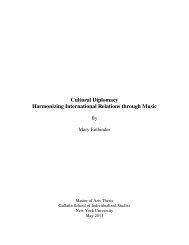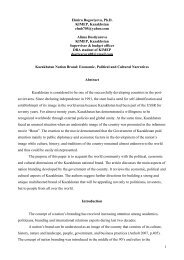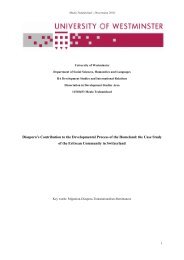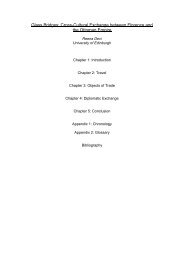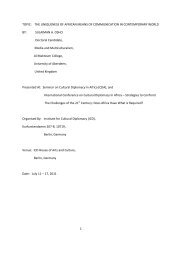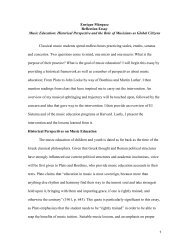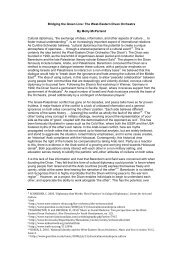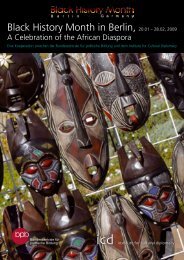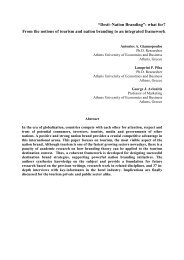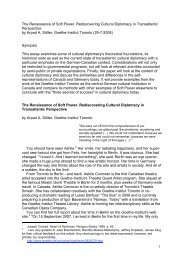Hable con ella - Institute for Cultural Diplomacy
Hable con ella - Institute for Cultural Diplomacy
Hable con ella - Institute for Cultural Diplomacy
You also want an ePaper? Increase the reach of your titles
YUMPU automatically turns print PDFs into web optimized ePapers that Google loves.
Pina Bausch in Pedro Almodóvar’s <strong>Hable</strong> <strong>con</strong> <strong>ella</strong> 429<br />
the subject of discourse and is <strong>con</strong>sidered a multilayered text that not only is the object of<br />
analysis but also writes history itself (Jeschke 2–3). Recent approaches in dance research,<br />
led by Anglo-American academic discourse, have identified the body, movement, and<br />
dance as significant subjects of interdisciplinary studies (Balme 23). Further important<br />
impulses <strong>for</strong> research on dance theatre originated from the relatively young academic<br />
discipline of per<strong>for</strong>mance studies, which opened up the <strong>con</strong>cept of per<strong>for</strong>mance, including<br />
“any event, action, item or behaviour” (Schechner 10), as a possible subject of examination<br />
as per<strong>for</strong>mance, shifting the focus from meaning to function, from product to process,<br />
and interrogating anew the relationship between per<strong>for</strong>mance and hermeneutics. What is<br />
vitally important <strong>for</strong> this article’s reading of Bausch and Almodóvar is an understanding<br />
of the potential of per<strong>for</strong>mance: “Per<strong>for</strong>mances mark identities, bend and remake time,<br />
adorn and reshape the body, tell stories and allow people to play with behaviour that<br />
is ‘twice-behaved,’ not-<strong>for</strong>-the-first time, rehearsed, cooked, prepared” (Schechner 10–<br />
11). Per<strong>for</strong>mance studies has in fact maintained that, with the development of aesthetic<br />
per<strong>for</strong>mances (i.e. theatre, music, dance) in directions that blend genres – turning the<br />
per<strong>for</strong>mance into “per<strong>for</strong>mance art,” mixed media, “happenings,” or “intermedia” –<br />
the boundaries separating genres blur and that those separating art and life are broken<br />
through (Schechner 10–11). In a similar fashion, Erika Fischer-Lichte has expanded the<br />
understanding of what deserves our interest in studying per<strong>for</strong>mance. She emphasizes<br />
the importance of, and the curiosity <strong>for</strong>, examining the processes occurring during a production,<br />
a per<strong>for</strong>mance and the reception of a per<strong>for</strong>mance, and she argues <strong>for</strong> a more<br />
holistic view of “Produktions- und Rezeptions- bzw. Wirkungsästhetik”:<br />
[Eine] Ästhetik [des Per<strong>for</strong>mativen] fragt weniger nach den Bedeutungen, welche<br />
Darsteller und Publikum durch oder während einer Aufführung hervorbringen mögen;<br />
sie fokussiert vielmehr die per<strong>for</strong>mativen Prozesse des Herstellens, Verhandelns und<br />
Austauschens, die Darsteller und Zuschauer im Laufe der Aufführung vollziehen. (20)<br />
It is noteworthy that Fischer-Lichte’s <strong>con</strong>ception characterizes per<strong>for</strong>mance and the<br />
perception of per<strong>for</strong>mance as a dynamic, changing, and organic process. Akin to this<br />
view, and seeking to validate the specific generic qualities of dance with regard to the act<br />
of interpretation, the dance scholar Janet Adshead-Lansdale claims that the genre-specific<br />
transience and impermanence of dance needs to be viewed as a strength rather than a<br />
weakness. She rejects the idea of a “one-to-one correspondence between movement<br />
and meanings” and instead argues <strong>for</strong> interpretation as an “imaginative and intellectual<br />
process that associates movement and other elements of the dance with events and people,<br />
both within the movement/dance system and within wider artistic practices and cultural<br />
issues” (189). The inclusion of the broader cultural <strong>con</strong>text in the act of interpretation<br />
and the role of subjective “reading” by the viewer necessarily lead to the “multiplicity<br />
of possible narratives,” i.e. interpretations (189). As a <strong>con</strong>sequence, Adshead-Lansdale<br />
characterizes the “reader” (viewer) as the cocreator of a “mobile text” (dance) (203). This<br />
approach appears appropriate <strong>con</strong>sidering Bausch’s reluctance to be interpreted in any<br />
definite way, be it feminist or sociopolitical, and her much quoted statements about her<br />
work underscore this reluctance: “I just can’t say: ‘That’s how it goes [...]. I am watching



